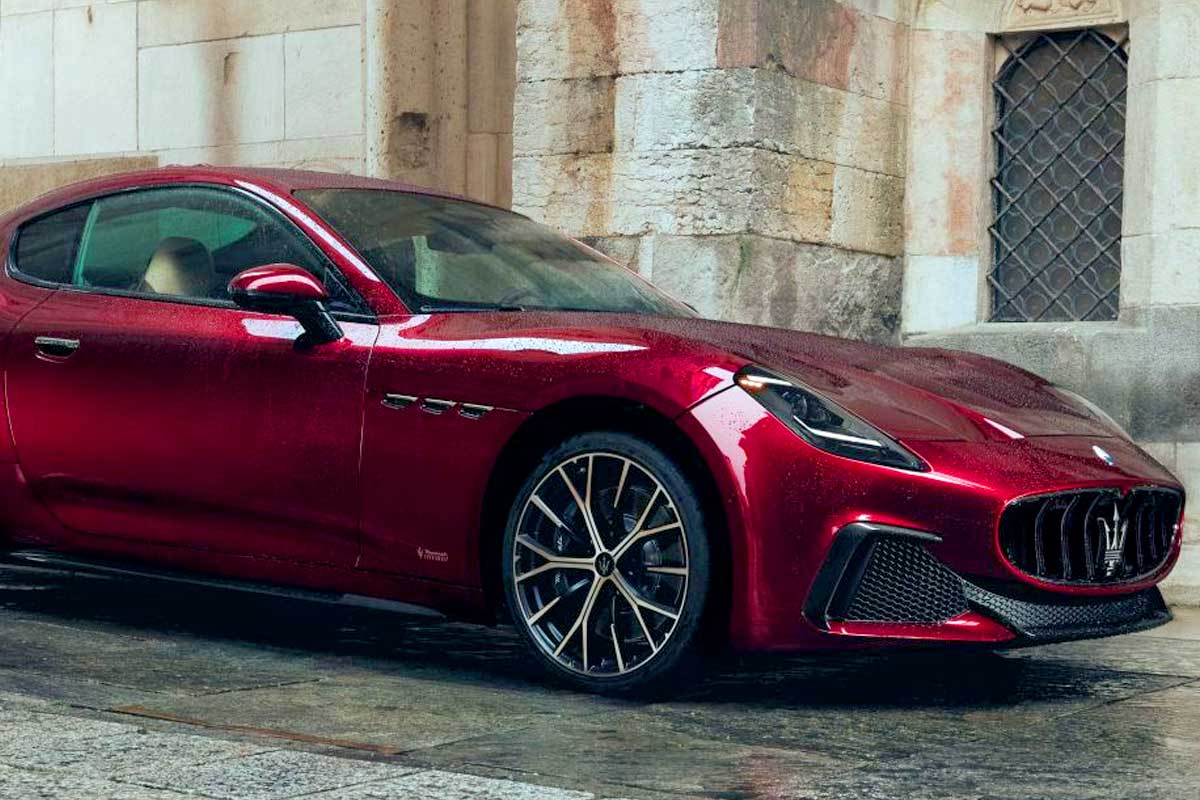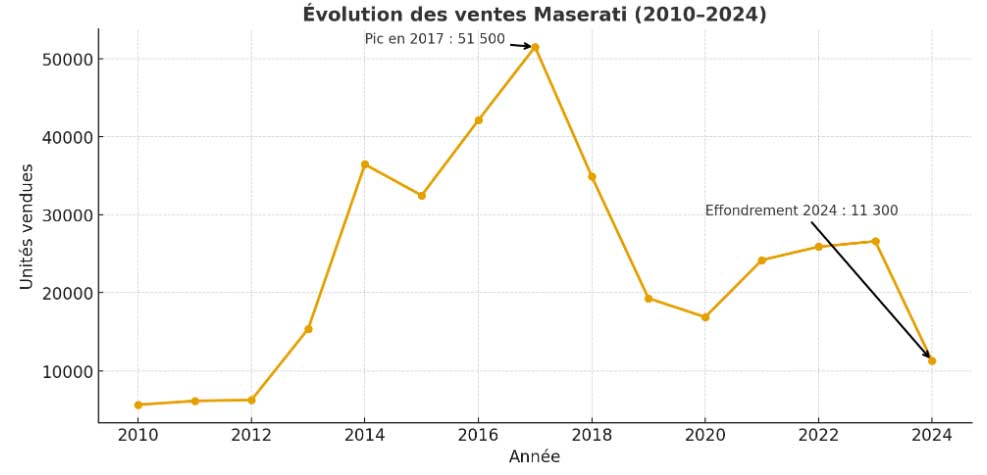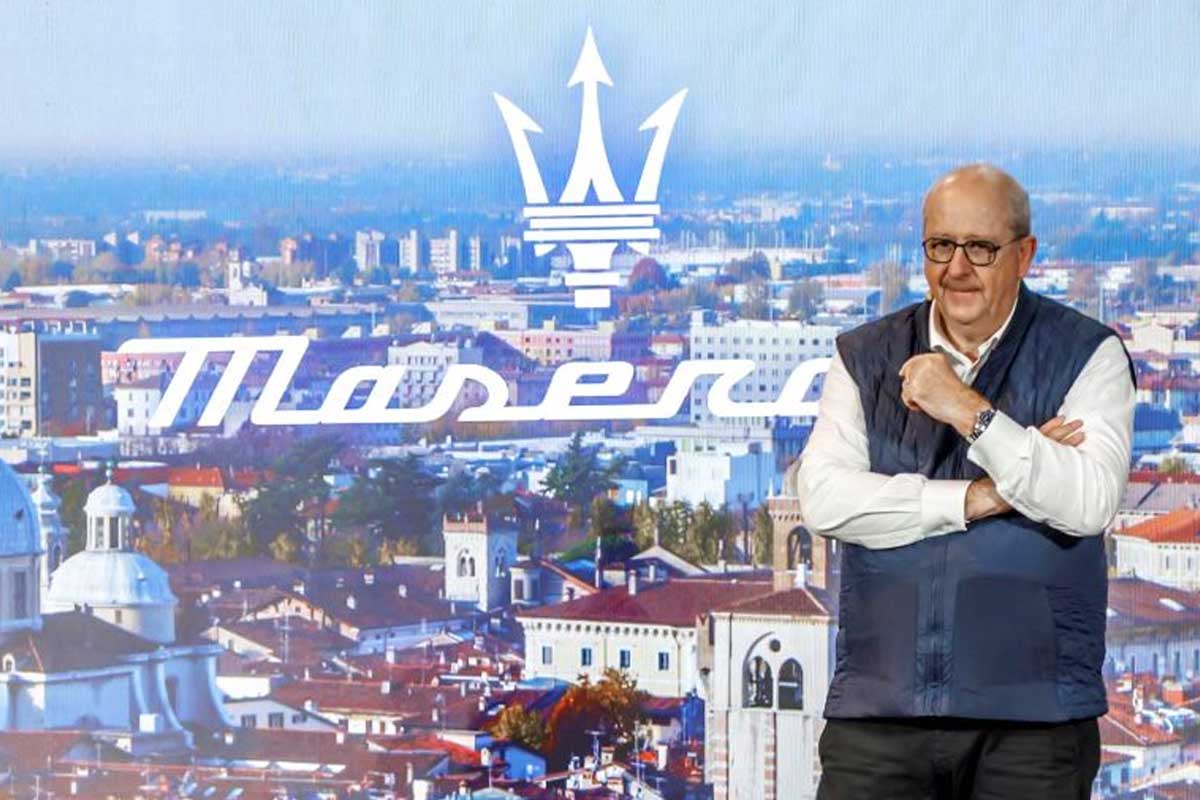
It's a subject we often raise here: Maserati must choose its path. Should it become a volume luxury brand, like Porsche, or position itself as a more exclusive brand, in the spirit of Ferrari or Lamborghini? After years of hesitation and roller-coastering, the answer finally seems to be in.
From dream to nightmare
For a long time, Maserati symbolized the Italian dream. Elegant models, noble engines, an aura of prestige. But behind this image, the figures tell a different story. After stable years of around 5,000 to 6,000 cars a year until 2013, the brand soared to 51,500 units in 2017. A short-lived success: since then, it's been a downward spiral. 11,300 units in 2024, and probably less than 10,000 in 2025.

The other side of the coin? Idling factories, overstocking, closing dealerships, short-time working... In just a few years, Maserati has gone from dream to industrial nightmare.
2024, a year of silence before the storm
After an already worrying 2023, 2024 was marked by a strange silence. Little communication, no real novelty, just appointment of a new CEO... which didn't stay that way for long. But things finally started moving: in June 2025, Stellantis had a new boss, and in October 2025, Jean-Philippe Imparato officially appointed CEO of Maserati.

As the former head of Alfa Romeo, he knows how difficult it is to relaunch an Italian brand within a major industrial group. And from his very first public appearances, the Frenchman has sent out a clear message.
Maserati targets profitability, not volumes
It was when production of the GranTurismo and GranCabrio was transferred from Mirafiori to Modena that Jean-Philippe Imparato gave his first directions for Maserati:
"For Maserati to be active, we only need to produce 15,000 to 20,000 cars a year. We don't need large volumes. We mustn't become generalists, but obsess about the customer and quality. An angry customer is a lost customer. [...] Our customers don't forgive mistakes, but this team knows how to get Maserati to the expected levels of profitability."
The objective is now clear: to return to profitability within two to three years, with an increase in residual value of 5 %.
Maserati opts for exclusivity
As a result, the Trident brand is resolutely siding with Ferrari and Lamborghini, with a positioning focused on exclusive luxury rather than volume. Gone is the temptation to compete with Porsche on sales figures. Maserati wants to produce less, but better. For dealers, often left to their own devices in recent years, this is a hopeful message. There's an implicit message here: "we're going to support you more".
If we set a 2-3 year horizon for profitability, this brings us to 2028 as the likely deadline for a Maserati range that is finally stabilized, coherent and delivered in good conditions.
The Giorgio platform retains its position
Another important point confirmed by Imparato is that the Giorgio platform, originally developed for Alfa Romeo, will remain at the heart of Maserati.
"We use it for GranTurismo, GranCabrio and Grecale. It will stay with us for the next ten years. And we can also shorten it to create more compact models. As long as I can use it, I will."
A statement that needs to be qualified: these models have only just begun their careers, and their life cycle could extend over 8 to 12 years. As for the idea of "more compact models", it's hard to imagine anything other than a new two-seater coupé, perhaps a resurrection of the Maserati Alfieri project?
The Nettuno V6 goes from strength to strength
Finally, Imparato confirmed what many had suspected: the electric transition will take longer than expected.
"The electric transition is not on schedule, but we can meet customer expectations by continuing to improve the V6," he explained.
The Nettuno V6, the company's technological jewel, has many years ahead of it. And unsurprisingly, it will be electrified to meet future standards. In a Stellantis group where noble engines are in short supply, it's only logical that Maserati should capitalize on this exclusive base.
A new era takes shape
Clearly, Maserati has finally found its direction: produce less but better, focus on quality, customer experience and sustainable profitability rather than artificial volumes. After years of trial and error, this strategy, at the crossroads of Ferrari and Lamborghini, is giving a clear direction back to the brand with the Trident.
It remains to be seen whether patience will be rewarded by 2028. In the meantime, Maserati will have to win back its customers, rebuild the confidence of its network, and prove that its ambition for exclusivity is no longer just talk, but a reality.
A huge relief to read this article: the Giorgio platform is not abandoned. The rest is common sense, but it had to be had. In the end, Imparato was the right choice, and I hope he stays on for more than a year.
Not abandoned for current models. For the Levante, it will be STLA Large. For the Quattroporte and the next Grecale too. I think the Giorgio platform could be kept for very exclusive models produced in Modena... Compare this to the way the URUS shares the Audi and the Temerario and Revuelto have their own platform.
For SUVs, why not with a higher seat height, but for a small model as prefigured with the Alfieri concept or a Quattroporte, it would be a mistake.
Imparato is the king of blabla...
In my humble opinion, it's better to wait before jumping for joy.
Maserati Alfieri? I'd love to!
It may be a good idea to do less volume at Maserati, but managers change their minds all the time. Folgore versions were supposed to sell well, and they hardly ever do.
Why replace the Giorgio platform with the wide STLA when there's no guarantee that the latter will be of the same standard? Why not keep the Giorgio Evo platform for future Alfa Romeo models?
Maserati and Alfa Romeo change direction like their shirts.
I think that, like a Cayenne, URUS, Purosangue, the STLA Large platform can do the trick, because the Levante will be a big SUV. They must have some idea of the qualities of the STLA Large platform, given that the new Stelvio, before being postponed, was almost ready.
There's still one big problem. FCA was already scary, now Stellantis is even scarier. Who wants to spend 150,000 euros on a Stellantis? This group, and the previous one too, has shown its inability to produce top-of-the-range products.
FCA wasn't scary, PSA was. It was when Ferrari took control of the brand via FCA that Maserati took a leap forward in reliability and quality.
The Alfieri should have been produced in its time, not 100 years later. It's like Alfa Romeo deciding to produce the Kamal now, once the train has passed!
台数よりも高級感や満足を優先するのは賛成だか、グレカーレのような廉価版は残してほしい
Fine, but I think they're taking a big risk, because Maseratis selling for less than €120,000 are selling, but if you go too far upmarket and try to become a real competitor to Ferrari and sell for much more, it's not certain that the clientele will follow.
but for the moment, they haven't mentioned a price. I'd be very surprised to see the future Maserati Levante priced like a Ferrai Purosangue.
Will there really be any new Maseratis? As is all too often the case with Italian cars, the lack of renewal is driving customers away. By 2028, we'll have to be patient or buy Chinese🤣. The only chance is that Jaguar screws up too.